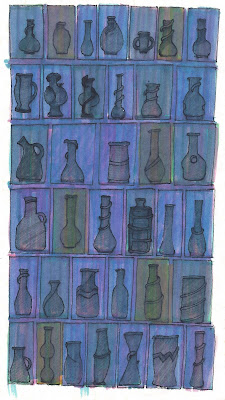Arion’s Dolphin, a
little press in Cambridge, published Kiss,
a collaborative sketchbook by Hannigan, John Batki, and Stratis Haviaras in
1977. The similar style of the three poet-artists is emphasized by collaboration;
to identify any one drawing as Hannigan’s for certain is difficult, in spite of
my familiarity with his work. (One image, a topless lady liberty made
faceless by fetish gear, is Haviaras’—the same image appears on the cover of the
Arion’s Dolphin chapbook, Jay Boggis’ Old World Courtesy, and is credited.)
Batki and Hannigan collaborated throughout the seventies. I've seen some of the results, and hope to see more (Batki tantalized me with mention of “the Pelikan book”).
“May & Jody,”
which we posted here in February, was so like their
collaborative work, we worried we’d left out Batki’s due credit. He confirmed
for us, however, that it’s pure Hannigan, “Oh that drawing is unmistakably
Paul's! How can there be any question about it???”
Hannigan edited an
issue of Ploughshares in 1976. Included in the issue is a portfolio of drawings
by one J. Gladstone. The drawings are not unlike drawings by Hannigan. The
issue presents a number of mysteries, which the bio notes only serve to enhance. For instance, Gladstone’s reads, “J. Gladstone and Harry V. Murphy are blood brothers.” Murphy’s reads, “Harry J. Murphy is a friend of J. Gladstone.” (These notes are consistent with
the joke Hannigan makes with/of the bio notes—that he is personal friends with nearly
everyone published in the issue (he was), and that the only way to get into
Ploughshares is to be pals with the editor.) So what’s with the different middle
initial? A typo, or a clue? And Murphy's contribution? It's called "Harry Murphy." Anyway, I’ve wondered if Hannigan was Gladstone.
To go a little
further into my conspiracy theory: the issue’s cover is a pen and ink drawing
of a woman smoking. In the lower left hand corner is the date 1936. The artist
is not credited anywhere in the issue. I originally assumed that meant the
artist was Gladstone, but the drawing isn’t quite like those in the portfolio.
Could it be by Hannigan? What does the date mean? Hannigan was born in 1936.
Then there’s the
question of Moophy Sweezy’s story “Boomerang Tears.” No one has yet been able
to confirm that there really is a Moophy Sweezy and her (?) bio note, “que sais-je
moi?” certainly doesn’t diminish my suspicion that Sweezy is Hannigan.
Certainly, the story bears a resemblance to Hannigan’s fiction.
I hope you’ve enjoyed
my “Paul is dead”-esque conspiracy theory. Enjoy “May & Jody,” which is by
Hannigan. If anyone has any answers, I'm listening.





